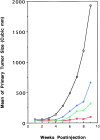Thrombospondin-1 is downregulated by anoxia and suppresses tumorigenicity of human glioblastoma cells
- PMID: 10811871
- PMCID: PMC2193158
- DOI: 10.1084/jem.191.10.1789
Thrombospondin-1 is downregulated by anoxia and suppresses tumorigenicity of human glioblastoma cells
Abstract
Angiogenesis, the sprouting of new capillaries from preexisting blood vessels, results from a disruption of the balance between stimulatory and inhibitory factors. Here, we show that anoxia reduces expression of thrombospondin-1 (TSP-1), a natural inhibitor of angiogenesis, in glioblastoma cells. This suggests that reduced oxygen tension can promote angiogenesis not only by stimulating the production of inducers, such as vascular endothelial growth factor, but also by reducing the production of inhibitors. This downregulation may significantly contribute to glioblastoma development, since we show that an increase in TSP-1 expression is sufficient to strongly suppress glioblastoma cell tumorigenicity in vivo.
Figures











References
-
- Fults D., Brockmeyer D., Tullous M.W., Pedone C.A., Cawthon R.M. p53 mutation and loss of heterozygosity on chromosomes 17 and 10 during human astrocytoma progression. Cancer Res. 1992;52:674–679. - PubMed
-
- Li J., Yen C., Liaw D., Podsypanina K., Bose S., Wang S.I., Puc J., Miliaresis C., Rodgers L., McCombie R. PTEN, a putative protein tyrosine phosphatase gene mutated in human brain, breast, and prostate cancer. Science. 1997;275:1943–1947. - PubMed
-
- Steck P.A., Pershouse M.A., Jasser S.A., Yung W.K., Lin H., Ligon A.H., Langford L.A., Baumgard M.L., Hattier T., Davis T. Identification of a candidate tumour suppressor gene, MMAC1, at chromosome 10q23.3 that is mutated in multiple advanced cancers. Nat. Genet. 1997;15:356–362. - PubMed
-
- Gall C.M. Angiogenesis in human astrocytomas. In: Black P.M., Schoene W.C., Lampson L.A., editors. Contemporary Issues in Neurological Surgery. Astrocytomasdiagnosis, treatment, and biology. Blackwell Scientific Publications; Boston: 1991. pp. 241–249.
-
- Stan A.C., Nemati M.N., Pietsch T., Walter G.F., Dietz H. In vivo inhibition of angiogenesis and growth of the human U-87 malignant glial tumor by treatment with an antibody against basic fibroblast growth factor. J. Neurosurg. 1995;82:1044–1052. - PubMed
Publication types
MeSH terms
Substances
Grants and funding
LinkOut - more resources
Full Text Sources
Other Literature Sources
Miscellaneous

